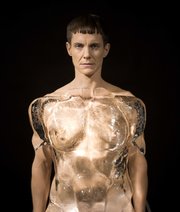Cassils: Transgender Artist Goes to Extremes
The Canadian transgender artist Cassils specializes in physically demanding performances that often require intense training regimens to transform the artist’s form into that of a bodybuilder or a mixed martial artist.
“I see the body as a social sculpture,” says Cassils, whose work has critiqued the pursuit of an unsustainable physique or the difficulty of representing violence in art. One of Cassils’ first major performances required the artist to stand still, nude, for five hours flush against an ice sculpture of a neoclassical male bust until it melted from the artist’s body heat.
Cassils’s more recent work has been even more provocative. This month, for the Spill Festival at London’s National Theater, Cassils was set on fire for 14 seconds, a “static burn” considered particularly dangerous by the stunt coordinators who trained and advised the artist. The piece, “Inextinguishable Fire,” required Cassils not to inhale (to keep from scorching the esophagus) and to wear a freezing fireproof suit that induces hypothermia (to avoid perspiration, which would otherwise boil on the surface of the skin).
Feats like these have led to increasing exposure for the Los Angeles-based artist. This summer, the MU art center in Eindhoven, the Netherlands, held Cassils’s first solo museum show. The artist is also participating in a major group show about gender and sexual identities at the Deutsches Historisches Museum and the Schwules Museum in Berlin. (The show’s poster is a photograph of Cassils, shirtless and muscular, with bright red lipstick.) In the following edited interview, Cassils discusses some of the ideas behind the challenging work.
Q. I’m sure you’re asked this quite often, but why did you light yourself on fire?
A. In 2002, I graduated from Cal Arts [California Institute of the Arts], which is this essentially Marxist grad school, and went back to my old day job of working as a personal trainer at Crunch in West Hollywood. There I watched the battle of Fallujah on 22 different monitors simultaneously while blonde actresses were running at their optimal fat burn target heart rate. The disparity between those realities really informed this piece. But the title comes from Harun Farocki’s documentary “Inextinguishable Fire” [which deals with the Vietnam War]. There’s this moment where he’s smoking a cigarette and he looks into the camera and says, “The embers from this cigarette burn at 400 degrees Celsius and Napalm burns at 3,000.” And then he extinguishes the cigarette in his arm.
Q. While your performance refers to a similarly extreme act, it’s controlled. There’s no intent to harm yourself.
A. Well, there’s always some risk. And the fact is, in the live performance in London, the tension in the room was unbelievable. And it was helped along by the fact that the stunt coordinator had never done this sort of thing as a live performance and he underestimated the power of stage fright. His hands were shaking as he was putting the fireproof garments and this protective goop on me — to the point that it was blocking my nostrils and my mouth and I couldn’t breathe. And because I had everything miked, the sound created an intimacy, a kind of acoustic focus. You can hear me telling him, “Look I can’t breathe, you gotta take some of this out.” It wasn’t acting, it wasn’t rehearsed, it was an actual moment. And that tension in this simulated environment makes you think about what it would be like to have it not be a consensual performance. What would it mean for an actual body to be experiencing this? I am not self-immolating, I’m doing a controlled action, but it references the constant barrage of images we have of traumatized bodies.
Q. What was the reaction to the performance?
A. People said they were sick to their stomachs, that they were shaking. People were having these intense empathetic physical reactions. The minute you start to strip the garment off, there’s so much adrenaline and, even though you haven’t been burnt, the body has sent stress signals, so there’s a convulsing that happens partly due to the hypothermia and partly due to the body being traumatized slightly. And then you just undergo an after-care, which is to warm up, and then those sensations subside.
Q. How does a piece like this relate to transgender politics?
A. It’s about not having a fixed body, but a body that’s in a constant state of flux. My goal is to hopefully ask people to think more critically. When you look at me, you’re not seeing my body, you’re seeing, in this case, an abstracted human form engulfed in flames, and you can place yourself in that position for a moment and think about what it would be like to be subjected to that violence. Thinking about that may change the way you walk through the world. Stephen Heyman.

